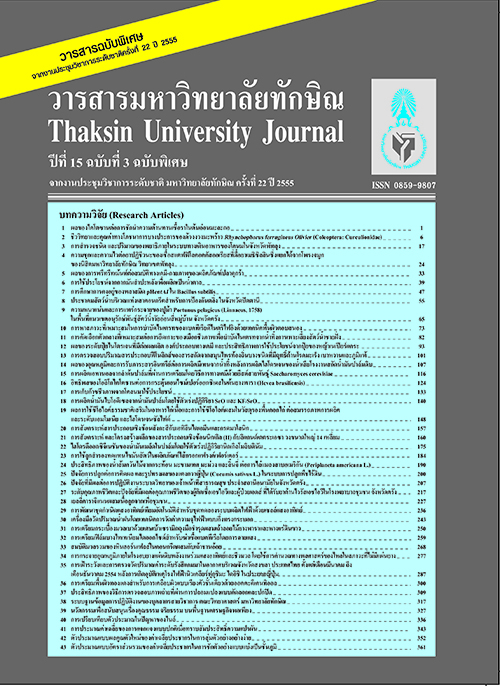การคัดเลือกตัวกลางที่เหมาะสมต่อการยึดเกาะของเมือกชีวภาพเพื่อบำบัดไนเตรท จากน้ำทิ้งการเพาะเลี้ยงสัตว์น้ำชายฝั่ง
Main Article Content
Abstract
ทำการศึกษาเปรียบเทียบชนิดของตัวกลางที่เหมาะสมต่อการเกิดเมือกชีวภาพในการบำบัดไนเตรท ในน้ำเสียสังเคราะห์จากการเพาะเลี้ยงสัตว์น้ำชายฝั่งที่ระดับความเค็ม 15 พีพีทีด้วยระบบการทดลองแบบกะ โดยใช้ ตัวกลาง 4 ชนิดคือ ไบโอบอล หินภูเขาไฟ เปลือกหอยนางรม และแผ่นอวนไนลอนชนิดทอไม่มีปม เปรียบเทียบ กับชุดควบคุม ติดตามประสิทธิภาพการบำบัดน้ำทางเคมี ร่วมกับการตรวจลักษณะของเมือกชีวภาพด้วยกล้อง จุลทรรศน์แบบฉากสว่างและแบบส่องกราด และตรวจสอบชนิดและปริมาณของแบคทีเรียที่เกี่ยวข้องด้วยเทคนิค Fluorescence In Situ Hybridization (FISH) และการนับปริมาณแบคทีเรียดีไนตริไฟอิงด้วยเทคนิค MPN แบบ ไมโครเทคนิค ผลการศึกษาพบว่าแผ่นอวนไนลอนที่ตัดเป็นชิ้นสี่เหลี่ยมขนาด 1×1 นิ้ว มีประสิทธิภาพดีที่สุดในการ บำบัดไนเตรท เนื่องจากมีลักษณะโครงสร้างของตัวกลางเหมาะสมต่อการยึดเกาะของจุลินทรีย์ ระบบสามารถเข้าสู่ สภาวะคงที่ได้เร็วที่สุด สอดคล้องกับการผลการนับปริมาณแบคทีเรียดีไนตริไฟอิง พบว่าในช่วงแรกของการทดลอง พบการเกิดเมือกชีวภาพบางๆ แต่เมื่อระบบดำเนินไปอย่างต่อเนื่องพบว่าเมือกชีวภาพเริ่มหนาและจับเกาะตัวกัน เป็นกลุ่ม ตรวจพบปริมาณแบคทีเรียในไฟลัม Proteobacteria คลาส Gammaproteobacteria เป็นกลุ่มเด่น
This study was to compare 4 types of media suitable for biofilm formation prior to be used in semi-batch system for nitrate removal from synthetic coastal aquaculture wastewater at 15 ppt salinity. They were bioball, pumice, oyster shell and a square cut woven nylon net (1×1 inch) and suspended system as a control experiment. The selection criteria were to monitor each reactor’s performance of nitrate removal using chemical analysis and the observation of biofilm characteristics using microscope both light and scanning electron microscopes.. In addition, the bacterial communities involving to nitrate removal were investigated using Fluorescence In Situ Hybridisation (FISH) technique and MPN with microtechnique analyses. It was found that the nylon net showed the best nitrate removal performance. This may mainly due to the proper structure and physical characteristic of nylon net for bacterial adhesion. It was confirmed with the presence of denitrifying bacteria when using MPN with microtechnique analysis and the dominant of bacteria belong to Gammaproteobacteria group when using FISH technique.


